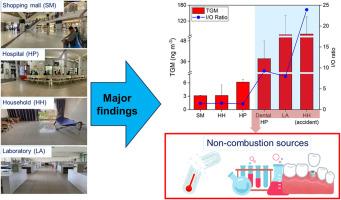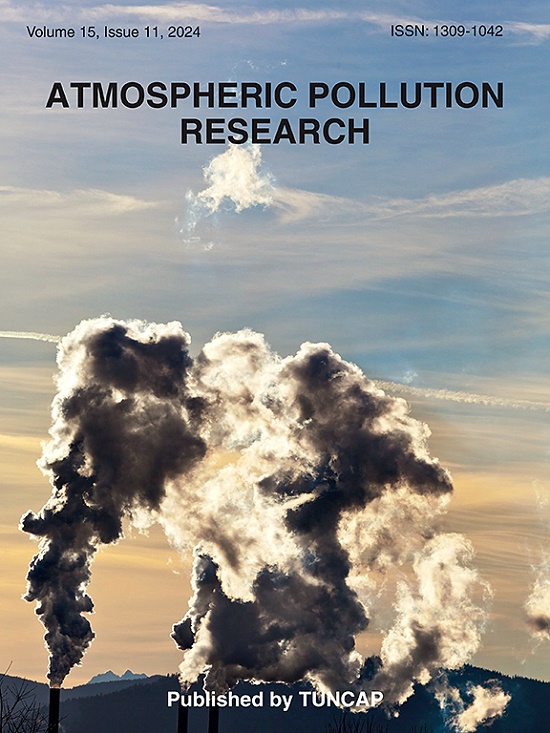Concurrent measurements of atmospheric Hg in outdoor and indoor at a megacity in Southeast Asia: First insights from the region
IF 3.5
3区 环境科学与生态学
Q2 ENVIRONMENTAL SCIENCES
引用次数: 0
Abstract
Atmospheric mercury (Hg) is a critical indoor (ID) air pollutant and necessitates stringent monitoring. However, studies have primarily focused on Hg outdoors (OD) compared to ID, with no investigations conducted within the Southeast Asia (SEA) region. In this study, total gaseous Hg (TGM) concentrations and human exposure levels were investigated across various site characteristics in Ho Chi Minh City (HCMC), a megacity in SEA. The measured TGM concentrations for OD and ID were 5.12 ± 6.87 ng m−3 (1.20–48.7 ng m−3) and 34.5 ± 60.3 ng m−3 (1.26–271.9 ng m−3). The overall ID/OD ratio was 5.01 (0.77–9.3), signifying markedly elevated ID TGM concentrations. This ratio increases in the following order: shopping malls (1.50) < hospitals (3.21) < chemical laboratories (5.76) < households (11.7). Notably, sites associated with Hg incidents and the utilization of Hg-contained chemicals demonstrate notably high ID/OD levels, ranging from 8.0 to 40.1. The use of Hg-containing chemicals within the chemical laboratory serves as a significant contributor to heightened ID TGM levels. Non-combustion Hg sources, therefore, play an important role in inducing the ID TGM level. The hazard index (HQ) values observed for ID and OD were 0.1 and 0.01, respectively, indicating a negligible risk of exposure to TGM within the study area. However, HQ values recorded within laboratory environments employing Hg-associated chemicals and dental hospitals were 1–17 times greater compared to other sites. The present work provides new insight into the non-combustion ID source of TGM and was helpful for upcoming studies in exploring potential sources of TGM in megacities.

在东南亚一个特大城市同时测量室外和室内的大气汞含量:来自该地区的第一手资料
大气汞(Hg)是一种重要的室内(ID)空气污染物,需要进行严格监测。然而,与室内相比,研究主要集中于室外(OD)的汞含量,在东南亚(SEA)地区还没有进行过调查。本研究调查了东南亚特大城市胡志明市(HCMC)不同地点的总气态汞(TGM)浓度和人体接触水平。测得的 OD 和 ID 的 TGM 浓度分别为 5.12 ± 6.87 纳克 m-3 (1.20-48.7 纳克 m-3)和 34.5 ± 60.3 纳克 m-3(1.26-271.9 纳克 m-3)。总的 ID/OD 比率为 5.01(0.77-9.3),表明 ID TGM 浓度明显升高。该比率依次为:商场(1.50);医院(3.21);化学实验室(5.76);家庭(11.7)。值得注意的是,与汞事故和使用含汞化学品有关的场所的 ID/OD 水平明显较高,从 8.0 到 40.1 不等。在化学实验室中使用含汞化学品是导致 ID TGM 水平升高的重要原因。因此,非燃烧汞源在引起 ID TGM 水平方面起着重要作用。在 ID 和 OD 中观察到的危险指数(HQ)值分别为 0.1 和 0.01,表明在研究区域内接触 TGM 的风险可以忽略不计。不过,在使用与汞有关的化学品的实验室环境和牙科医院中记录的 HQ 值是其他地点的 1-17 倍。本研究工作为我们提供了有关三卤甲烷非燃烧 ID 来源的新见解,有助于今后探索特大城市中三卤甲烷潜在来源的研究。
本文章由计算机程序翻译,如有差异,请以英文原文为准。
求助全文
约1分钟内获得全文
求助全文
来源期刊

Atmospheric Pollution Research
ENVIRONMENTAL SCIENCES-
CiteScore
8.30
自引率
6.70%
发文量
256
审稿时长
36 days
期刊介绍:
Atmospheric Pollution Research (APR) is an international journal designed for the publication of articles on air pollution. Papers should present novel experimental results, theory and modeling of air pollution on local, regional, or global scales. Areas covered are research on inorganic, organic, and persistent organic air pollutants, air quality monitoring, air quality management, atmospheric dispersion and transport, air-surface (soil, water, and vegetation) exchange of pollutants, dry and wet deposition, indoor air quality, exposure assessment, health effects, satellite measurements, natural emissions, atmospheric chemistry, greenhouse gases, and effects on climate change.
 求助内容:
求助内容: 应助结果提醒方式:
应助结果提醒方式:


